, Restoring a Priceless Masterpiece Section by Section:
Restoring a Priceless Masterpiece Section by Section:
A “State of the Organ” Report
Where we’ve been and where we need to go
Restoration is a continuous artistic obligation for an instrument of the exceptional magnitude and beauty possessed by the Wanamaker Organ.
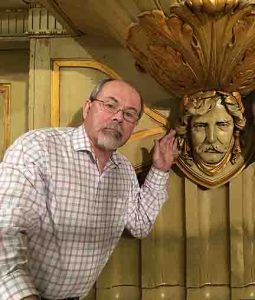
Since the Friends was founded 29 years ago, our goal has been to completely restore a whole section of the Organ at a time, so that each restored unit is completely renewed and entirely dependable. That cuts down on costly expeditions to the far corners of the instrument to to make small but time-consuming repairs to randomly failing parts. The more of the organ that is restored, the more our crew can focus on pure wholesale restoration.
Because disturbed dirt and dust travels downward, and because reed pipes are sensitive to any particles that land on their moving tongues, restoration in the Main Chamber is being done from the top down so that expensive reed cleaning does not need to be re-done because of activity going on above.
Our restoration program is based on private giving, and the more the Friends receives the more it is able to accomplish. Increased public giving also entitles us to increased grant amounts., and encourages Macy’s to continue its generous involvement. Please consider joining the Friends to advance our work. Macy’s remains a committed partner.
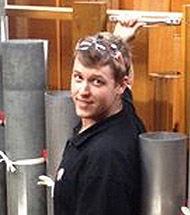
During the ongoing century, the prime mover and architect of our restoration has been our brilliant curator Curt Mangel, who has designed an ingenious blower humidification system, created a versatile relay system, brilliantly restored chests, divisions and percussion stops, and has liberated portions of the organ that were formerly buried behind pipes or architecture. Now their tone can sing into the room unimpeded.
Curt also redesigned the Christmas Light Show with figures that allow sound through the panels, and replaced the heavy draperies with a sound-friendly scrim backdrop. The enclosure of upper floors of the Grand Court in glass has given the room a wonderful reverberance it never before possessed.
Present Primary Focus
The Solo
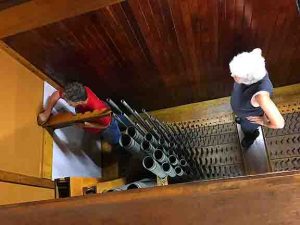
The Solo is prone to high-pressure ventil-chest problems. Aged pneumatics (mechanical bellows working on air pressure differences) can tear and leak wind. This can result in dead notes. If enough pneumatics are torn, it weakens the playing signal for each note and pressurizing chambers of stops that are turned off. This results in both a sluggish playing action and random notes coming from stops that are turned off.
The Solo division by itself has 51 ranks and is the size of a well-equipped church organ. By way of comparison, the substantial organ in the Philadelphia Cathedral Basilica uses has only 14 more sets of pipes. As its name suggests, the Solo is primarily designed for melody playing, but batteries of diapasons, reeds and strings also lend themselves to rich, powerful chords useful for accents, fanfares, and bold statements.
Because we plan to restore divisions from the top of the Main Chamber down (to keep dirt from restoration activities falling into cleaned reeds), a total chamber restoration is high on the priority list. Also, problems from sound-absorbing chamber surfaces are being rectified here and elsewhere with medium density fiberboard (MDF), known for its sound reflectivity. At present, two substantial mixtures at the top of the chest are being restored. The chamber ceiling has been coated with many layers of polyurethane varnish, and the MDF boardings are being applied over old sound-absorbing fiber panels to enhance projection of the tone in this very deep chamber. Seven sets of reeds have been restored and are awaiting funding for their re-installation.
Funding for the Solo restoration has generously given in honor of John Binsfeld by the Seifert family under the Barbara V. Watson Charitable Trust; by Dr. Charles Bower; and by the Wyncote Foundation.
Totally Restored Sections
The Case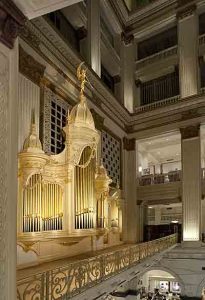 The Wanamaker Organ Case is the Friends of the Wanamaker Organ’s most recent complete restoration, and it was accomplished with generous gifts from Macy’s, from the Wyncote Foundation, from the Michael Stairs Memorial Fund and from friends of Alan Grubb, an Angola, IN, police dispatcher who made a pilgrimage to hear the Organ during what became his final illness.
The Wanamaker Organ Case is the Friends of the Wanamaker Organ’s most recent complete restoration, and it was accomplished with generous gifts from Macy’s, from the Wyncote Foundation, from the Michael Stairs Memorial Fund and from friends of Alan Grubb, an Angola, IN, police dispatcher who made a pilgrimage to hear the Organ during what became his final illness.
The case was designed by store architect Daniel Hudson Burnham and built in 1910 by the Meader Furniture Company, a firm specializing in building fittings. It was brought back to its original old ivory and gold leaf ornamentation, from its previously battered condition where its greenish, Gulden’s mustard color had to be disguised with floodlighting, all stemming from a century of dirt, stains and pollution. Three-and-a-half pounds of 22-karat gold were placed on the pipes, ornamentation and human-scale angel by expert artisans from the Evergreene Architectural Arts Company.
A film on the pipe gilding is HERE.
Funding for the case restoration was generously given by Macy’s, the Wyncote Foundation, friends of Michael Stairs, and friends of Alan Grubb.
The Console The console was the first component of the Organ to undergo complete restoration, a project that lasted from about 1989 to 1997. Each of its 100,000 components was taken apart, meticulously cleaned, refinished, and reassembled so that an electronic combination action could be installed. The original combination action received a major upgrade as the generous gift of Robert A. Haines and family, and has since been further improved with additional memory levels.
The console was the first component of the Organ to undergo complete restoration, a project that lasted from about 1989 to 1997. Each of its 100,000 components was taken apart, meticulously cleaned, refinished, and reassembled so that an electronic combination action could be installed. The original combination action received a major upgrade as the generous gift of Robert A. Haines and family, and has since been further improved with additional memory levels.
Following the console rebuild, blank stop tablets have been used for new purposes and our Opus-Two relay system has allowed novel effects and lightning-fast playing speed. In 2007-8 under curator Curt Mangel, the mahogany covering of the console was sumptuously restored to a magnificent finish, and in 2015 the wood enclosure was stripped of coats of paint and restored and gilded, with missing finials duplicated and replaced.
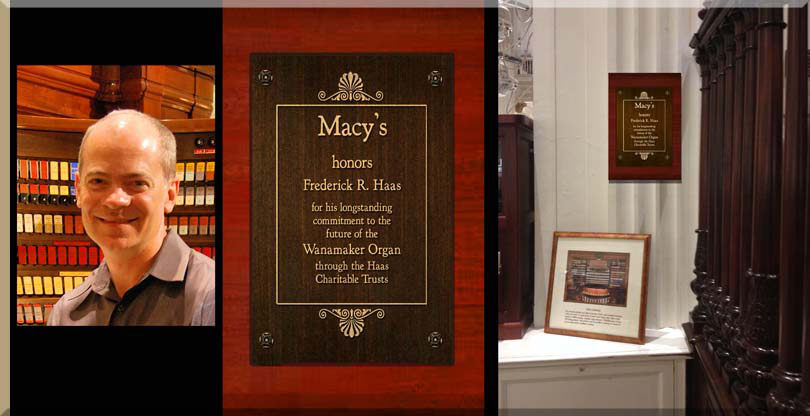 Macy’s and the Friends of the Wanamaker Organ restored the console loft and its carved wood enclosure, and dedicated it to Frederick R. Haas, noted arts patron and longtime champion of the Wanamaker Organ. A special plaque was placed in his honor just outside the console enclosure. Mr. Haas is often seen in the loft as one of Peter Richard Conte’s assistants.
Macy’s and the Friends of the Wanamaker Organ restored the console loft and its carved wood enclosure, and dedicated it to Frederick R. Haas, noted arts patron and longtime champion of the Wanamaker Organ. A special plaque was placed in his honor just outside the console enclosure. Mr. Haas is often seen in the loft as one of Peter Richard Conte’s assistants.
The Echo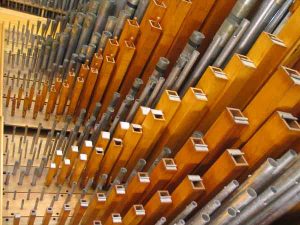 The lovely, soft Echo division on the 7th floor was thoroughly soaked during a building remodeling accident. Because of the massive chestwork design used by the Wanamaker Organ Shop, it was able to receive a complete restoration by Trupiano and Mann during the early 1990s. It was the first division to have all its pipework cleaned and woodwork refinished. The Echo has now performed faultlessly for 20 years. The division was still at the New York shop during the Woodward & Lothrop bankruptcy, and the Friends negotiated with Store executives to make sure its insurance liability claim was not a casualty of the Chapter 11 proceedings, when assets were assigned to creditors.
The lovely, soft Echo division on the 7th floor was thoroughly soaked during a building remodeling accident. Because of the massive chestwork design used by the Wanamaker Organ Shop, it was able to receive a complete restoration by Trupiano and Mann during the early 1990s. It was the first division to have all its pipework cleaned and woodwork refinished. The Echo has now performed faultlessly for 20 years. The division was still at the New York shop during the Woodward & Lothrop bankruptcy, and the Friends negotiated with Store executives to make sure its insurance liability claim was not a casualty of the Chapter 11 proceedings, when assets were assigned to creditors.
The Ethereal
The high-pressure Ethereal Division on the 7th floor was also water damaged during building reconstruction, and was carefully rebuilt by Carl Loeser. The scope of the contracted work was not as comprehensive as with the Echo, and although the division has received a great deal of additional restoration in the intervening years, some of the reeds still require cleaning and refurbishing.
The Orchestral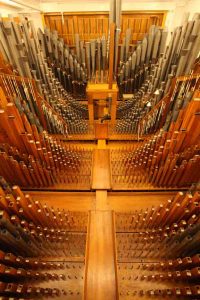 The Orchestral Division had been releathered in Perflex in the ’70s and was a casualty of that failed experiment in using a substitute for leather. Although the chests were taken apart in 1978 for renewal, it was not until 2005 that restoration began. Under the inspired leadership of Curt Mangel, and gifts from the late Edith Brickman, the Wanamaker Building owners and the Haas Charitable Trusts, the division was moved out of a chamber that directed a lot of its sound into a masonry wall, and placed in a completely new chamber on the Fourth Floor at right angles to the String. Possessing an unmatched assortment of Kimball reeds, all of which were restored by Sam Hughes, the Orchestral has functioned beautifully over the past decade.
The Orchestral Division had been releathered in Perflex in the ’70s and was a casualty of that failed experiment in using a substitute for leather. Although the chests were taken apart in 1978 for renewal, it was not until 2005 that restoration began. Under the inspired leadership of Curt Mangel, and gifts from the late Edith Brickman, the Wanamaker Building owners and the Haas Charitable Trusts, the division was moved out of a chamber that directed a lot of its sound into a masonry wall, and placed in a completely new chamber on the Fourth Floor at right angles to the String. Possessing an unmatched assortment of Kimball reeds, all of which were restored by Sam Hughes, the Orchestral has functioned beautifully over the past decade.
The Vox Humana choir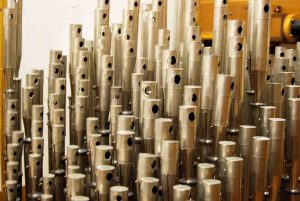 The Vox Humana Chorus was originally part of the Orchestral and was found at the rear of the chamber. When the Orchestral proper was moved to a new chamber, the Voxes were moved forward in the old chamber and became a separate, glorious, floating division. There was room in the new space for its two Pedal ranks, formerly in the String, to be united with the rest of the Voxes. Curator Curt Mangel designed a special tremulant system for the section that uses different patterns for different ranks. Here is another division requiring only regular tuning. For a short film showing the delight expressed when they were first heard in their new location, on December 2, 2006, CLICK HERE.
The Vox Humana Chorus was originally part of the Orchestral and was found at the rear of the chamber. When the Orchestral proper was moved to a new chamber, the Voxes were moved forward in the old chamber and became a separate, glorious, floating division. There was room in the new space for its two Pedal ranks, formerly in the String, to be united with the rest of the Voxes. Curator Curt Mangel designed a special tremulant system for the section that uses different patterns for different ranks. Here is another division requiring only regular tuning. For a short film showing the delight expressed when they were first heard in their new location, on December 2, 2006, CLICK HERE.
The Great Chorus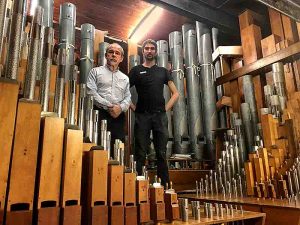 The Chorus was the final section to be put in the Organ, in the midst of the Great Depression and following Rodman Wanamaker’s death, and it had never been satisfactorily winded or voiced. Also its taller pipes blocked the sound from its smaller ones because the 8′ octave of each rank, with the big pipes, was placed on a chest in front of the remaining octaves of each rank for space reasons. Curt Mangel and our Shop completely rebuilt the Chorus and modernized its winding system in 2016, making it the supreme source of rich, unenclosed diapason tone its original designers sought. Crowning the division is the Diapason Magna, a double-languid stop of particular boldness that was the first such diapason ever built in the United States.
The Chorus was the final section to be put in the Organ, in the midst of the Great Depression and following Rodman Wanamaker’s death, and it had never been satisfactorily winded or voiced. Also its taller pipes blocked the sound from its smaller ones because the 8′ octave of each rank, with the big pipes, was placed on a chest in front of the remaining octaves of each rank for space reasons. Curt Mangel and our Shop completely rebuilt the Chorus and modernized its winding system in 2016, making it the supreme source of rich, unenclosed diapason tone its original designers sought. Crowning the division is the Diapason Magna, a double-languid stop of particular boldness that was the first such diapason ever built in the United States.
The Choir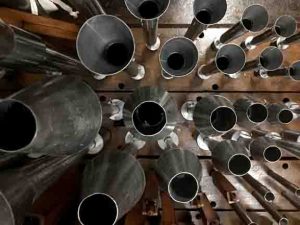 The Choir is only the second section of the original Murray M. Harris/Los Angeles Art Company organ to be thoroughly restored. (The original half of the Echo division was the first). The fine intonations of its stops and reeds are proving a revelation, particularly as the surrounding walls and ceiling have been meticulously cleaned and varnished. Reed restorer Samuel Hughes restored the two Saxophones, the Clarinet and the English Horn (pictured).
The Choir is only the second section of the original Murray M. Harris/Los Angeles Art Company organ to be thoroughly restored. (The original half of the Echo division was the first). The fine intonations of its stops and reeds are proving a revelation, particularly as the surrounding walls and ceiling have been meticulously cleaned and varnished. Reed restorer Samuel Hughes restored the two Saxophones, the Clarinet and the English Horn (pictured).
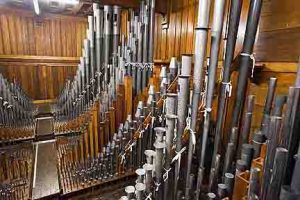
Maintained Sections Awaiting a Thorough Restoration
The String
The famous String Organ was also a Perflex experiment. Perflex was replaced with leather in the 1980s, but has not received a complete overhaul. Its pipes remain unwashed, and chest features, such as its pitman rails, have perhaps a few more years of serviceable life ahead. Wiring advances have allowed the Cellos to be played against other sections with semi-separate expression. Curt Mangel has created an extra set of stop pneumatics, and has been going through all the chests replacing these actions. The extra set means the stop actions of a chest can be releathered without having the chest out of service. The many String Pedal offset chests along the walls are particularly in need of a complete re-actioning.
The Swell
With 71 ranks, the Swell is the third largest division in the Organ, just behind the String and Pedal. An organ composed of all loud stops soon deafens the music lover’s ears to the aesthetic content of any tones so produced. The Wanamaker Organ is famed for rank upon rank of mezzo forte pipes, and this division has dozens of such sets in the Upper and Lower Swell—sections that urgently need thorough restoration. Among these are a baker’s dozen of softer reed stops possessing unique and beautiful imitative sounds.

There has been some progress in the Swell. The High Pressure Swell, originally the heart of the 1904 Solo Division, contains the deep “dark chocolate” reeds that are perhaps the most impressive in the Wanamaker. Some resonators needed to be carefully remade under Lord & Taylor’s patronage to replace originals that had been flattened through improper storage. The Stentorphone, our most powerful enclosed flue rank, also underwent restoration, fixing toes flattened by the pipes’ extreme weight. Dr. Charles Bower sponsored restoration of the Grand Corroborating Mixture V that crowns this ensemble. The Original String section of the Swell has been completely restored in a project dedicated to Assistant Organist Michael Stairs, through a generous gift of the Seifert family through the Barbara V. Watson Charitable Trust.
When Curator Curt Mangel doubled up the massive pipes of the 32′ Open Metal that had been directly in front of the Swell’s shades, the new opening enabled these gorgeous Swell stops to be heard unimpeded by the “wall of zinc” they had previously played through.
The Reeds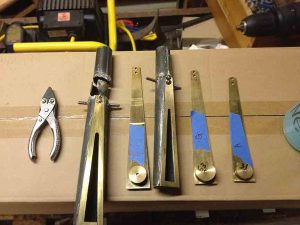 Reed stops are some of the most dramatic and important voices in the Wanamaker Organ, but dozens of them are in need of a thorough cleaning. Select voices in the Solo, Swell and Ethereal have been cleaned, as have all the reeds in the Echo, Orchestral, Choir and Vox chambers. Cleaning reed stops is expensive, and many fine voices in the Ethereal, Solo, Swell, Great and Pedal await their return to greatness. Some, in fact, are not used at all at present because they are covered in a fine coating of soot and dust particles from more than a century of air passing through them, and easily go out of tune. Having a reed rank restored is an attractive project for gifts or memorials, such as the Contra Bombarde restoration given by Thomas Jefferson V and shown at right pre-restoration.
Reed stops are some of the most dramatic and important voices in the Wanamaker Organ, but dozens of them are in need of a thorough cleaning. Select voices in the Solo, Swell and Ethereal have been cleaned, as have all the reeds in the Echo, Orchestral, Choir and Vox chambers. Cleaning reed stops is expensive, and many fine voices in the Ethereal, Solo, Swell, Great and Pedal await their return to greatness. Some, in fact, are not used at all at present because they are covered in a fine coating of soot and dust particles from more than a century of air passing through them, and easily go out of tune. Having a reed rank restored is an attractive project for gifts or memorials, such as the Contra Bombarde restoration given by Thomas Jefferson V and shown at right pre-restoration.
The Great
The Great Organ is almost as large as the Swell. The pipework in the Enclosed section is in need of a thorough cleaning and reed rejuvenation—like that recently performed on the Choir pipework found at the rear of the big chamber they share. After that, the Unenclosed Great, which is directly below, needs the same thorough restoration. The nearby Tibia Chests also await a thorough re-actioning and cleaning from a century of accumulated grime.
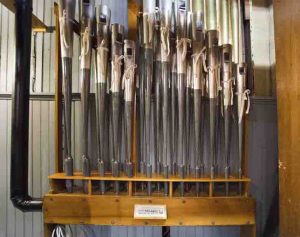
The Pedal
The Pedal Division has 75 ranks. Its Pedal resources from the Ethereal, Echo, Orchestral, Great Chorus area, the Contra Bombarde 32′ and the Pedal Voxes have all been completely restored. The Pedal Upperwork Chest and the Pedal/Great Mixture VIII have also been completely re-actioned, But the pipework, choked with dust from being out in the open, has not yet been cleaned.
There is a huge Main Pedal chest from the original organ with pipes in need of a thorough cleaning. The remainder of the Pedal, which is also in need of restoration, consists of offset chests mounted around the main chamber. The Pedal suffers from a very large number of dead notes, a situation that is slated to be improved during 2018. At some point more serious restoration is imperative.
The Pedal Contra Bombarde was entirely restored by the late Thomas Jefferson V in memory of his parents Thomas L. Jefferson IV and Judith Wagstaff Jefferson. The Main Pedal Metal Double Open Diapason is being restored through a generous gift of Dr. Charles Bower, who is also restoring the Pedal Grand Mutation section
The Percussion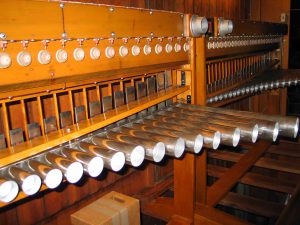 This collection of musical instruments is mainly playing. The Celesta and Piano have been painstakingly restored. The Metalophone is in good operating condition, as are the Minor Chimes, which have been upgraded with a set of tubes from an Aeolian organ so the stop is dead in tune with the rest of the instrument.
This collection of musical instruments is mainly playing. The Celesta and Piano have been painstakingly restored. The Metalophone is in good operating condition, as are the Minor Chimes, which have been upgraded with a set of tubes from an Aeolian organ so the stop is dead in tune with the rest of the instrument.
An Aeolian Harp was meticulously restored and added in the Choir under expression, and a Giant Gong is close to being installed (Story on Page 4). Also under restoration is a set of Tuned Gongs. The imposing Major Chimes are functioning, but will likely need a complete overhaul in the near future.
The Wiring
Wiring and relays are the nervous system of the Wanamaker Organ. Any failure leads to a paralysis somewhere in the instrument. Powering the wiring is a rectifier given by Lord & Taylor that supplies the fluctuation-free DC current required by the sensitive relay electronics. The installation of the Opus-Two relay system has vastly simplified the wiring of the Organ, as it allows signals to go through just a few wires rather than the thick cables necessary in the past.
A transmitter tells various receivers what stops are on and what notes are playing in frames of information that are interpreted and acted on at the chest. This information is updated in milliseconds. Opus-Two also allows for “trick effects,” such as creating percussions that repeat at the command of the software. Much of the Organ has been done, but a significant amount remains to be transitioned. The Fleming chests were once thought to be slow-acting , but the installation of these relays has shown them to respond just as fast as notes can be played.
The Wind Chests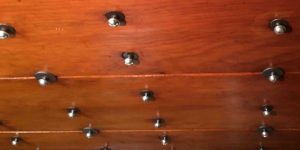 Springs holding bottom boards tight during winter drying have been installed in the String, Ethereal, Orchestral, Voxes, Chorus and Solo divisions. This assures that there are no problems with malfunctioning notes. (More on this is on the next page). As part of the programmed restoration, chests are being totally rebuilt along with the pipework planted on them.
Springs holding bottom boards tight during winter drying have been installed in the String, Ethereal, Orchestral, Voxes, Chorus and Solo divisions. This assures that there are no problems with malfunctioning notes. (More on this is on the next page). As part of the programmed restoration, chests are being totally rebuilt along with the pipework planted on them.
The Blowers
Two blowers, the String and Ethereal, were replaced with modified modern air-handling equipment during building remodeling. This is thought to have been a mistake, as these high-speed blowers create a lot of heat. Curt Mangel lessened this by having the blowers vent off hot air when demand is low. Also, affected divisions have been tuned when the wind is hot, making them tonally stable for long concerts or recording sessions.
Other blowers have been torn down and rebuilt. A rebuilt blower was added for the Orchestral. New starters allow blowers to turn slowly when the Organ is off during dry winter weather, wafting humid air from blower room swamp coolers through the wooden chests, keeping them humidified. Wood that is not humidified shrinks and causes air leaks and chest failures.
Wind leaks from bent air conduits are being addressed, and it is hoped that the starters for the remaining blowers can be activated soon. Much of this system and all of the Wanamaker Organ’s tonal resources are showcased in our Curators Tour DVD, available HERE. A companion Sonic Odyssey DVD surveys the sounds of all the instrument’s divisions in sessions with organists Peter Richard Conte and Thomas Murray. That DVD is available HERE.
For more information about the Organ and its Tonal Resources, please click HERE.
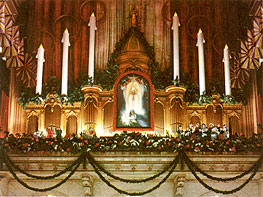
Light Show Evolution—with Christmas Display Review
The Store’s fabulous light show has always been one of Philadelphia’s most hallowed traditions since its inception in November 1955, as fountains lit by colored lights. This feature spotlights early Grand Court displays, and it is followed is followed by Larry Kerecman’s information-packed chronology of how the John Wanamaker Light Show evolved year by year. […]
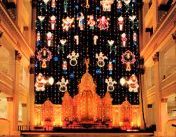
The Holiday Light Show
Fun Facts and Figures Past and Present There are 34,500 LED lights on the Macy’s Magic Christmas Tree in six colors: red, yellow, green, blue, purple, and cool white, which breaks down to about 5,750 lights in each color. It is topped by a red Moravian (or Advent) star. The lights on the tree, the […]

Enjoy Hours of Archived Shows from the WRTI Wanamaker Organ Hour!
A wonderful archive of shows from the WRTI Wanamaker Organ Hour program is available HERE for your Internet listening pleasure! (You must open this post for the link to work.) The site is maintained by Julien Girard, a French aficionado now living in Quebec, with French-language names for the month of the original broadcast dates.
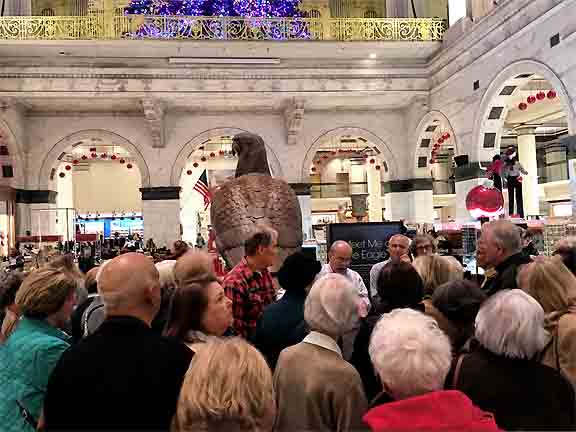
Tours of the Chambers
TAKE A TOUR! Admission to our monthly last-Saturday-of-the-month Organ Tours are available by securing admissions at our webstore Tour section. Advance notice is no longer required for groups of five or smaller. You may purchase your admissions clicking HERE and meet your tour guide Nik Sizgorich at noon at the Eagle on the designated tour […]


